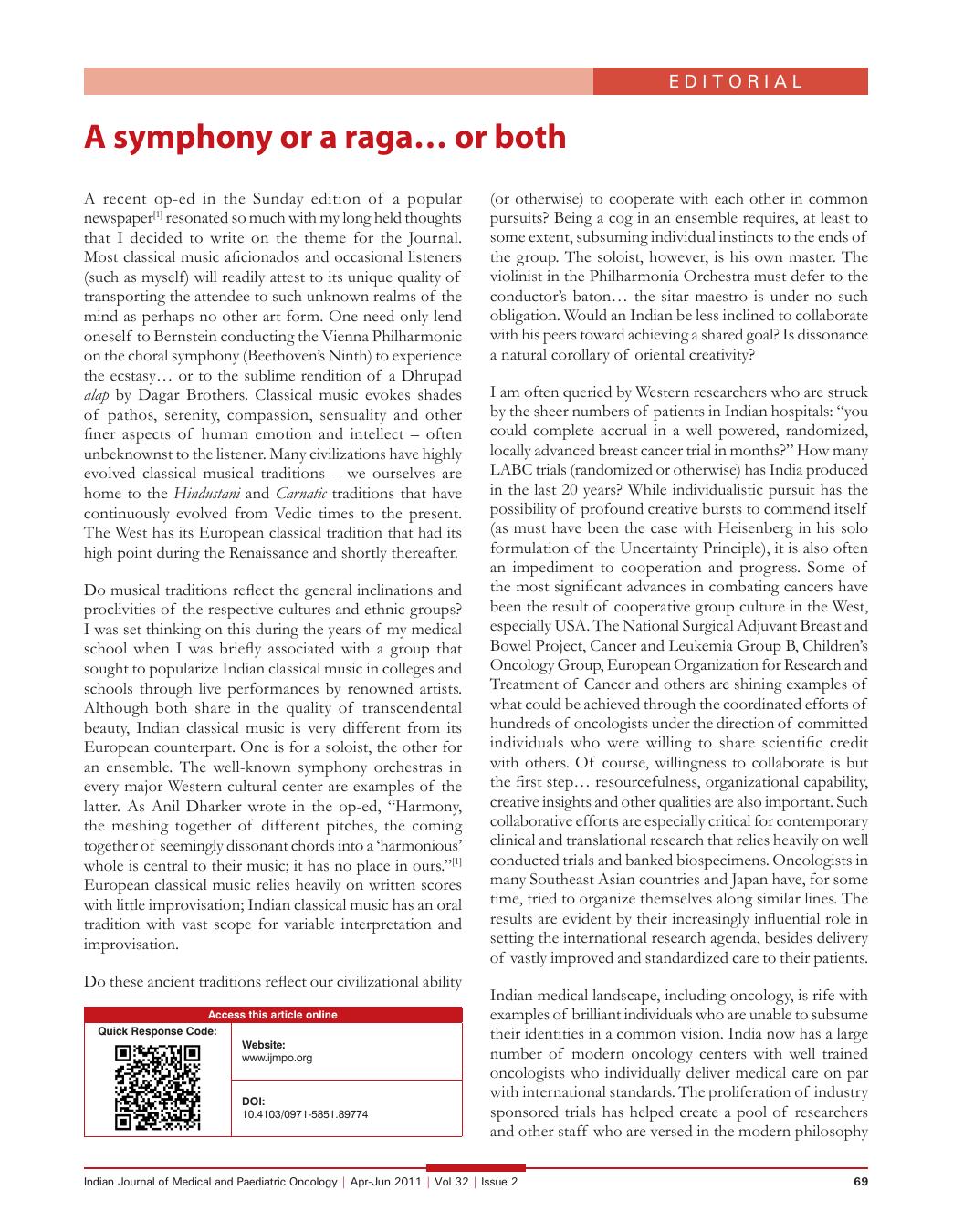A symphony or a raga...or both
CC BY-NC-ND 4.0 · Indian J Med Paediatr Oncol 2011; 32(02): 69-70
DOI: DOI: 10.4103/0971-5851.89774

Publication History
Article published online:
06 August 2021
© 2011. Indian Society of Medical and Paediatric Oncology. This is an open access article published by Thieme under the terms of the Creative Commons Attribution-NonDerivative-NonCommercial-License, permitting copying and reproduction so long as the original work is given appropriate credit. Contents may not be used for commercial purposes, or adapted, remixed, transformed or built upon. (https://creativecommons.org/licenses/by-nc-nd/4.0/.)
Thieme Medical and Scientific Publishers Pvt. Ltd.
A-12, 2nd Floor, Sector 2, Noida-201301 UP, India
A recent op-ed in the Sunday edition of a popular newspaper[1] resonated so much with my long held thoughts that I decided to write on the theme for the Journal. Most classical music aficionados and occasional listeners (such as myself) will readily attest to its unique quality of transporting the attendee to such unknown realms of the mind as perhaps no other art form. One need only lend oneself to Bernstein conducting the Vienna Philharmonic on the choral symphony (Beethoven's Ninth) to experience the ecstasy… or to the sublime rendition of a Dhrupad alap by Dagar Brothers. Classical music evokes shades of pathos, serenity, compassion, sensuality and other finer aspects of human emotion and intellect – often unbeknownst to the listener. Many civilizations have highly evolved classical musical traditions – we ourselves are home to the Hindustani and Carnatic traditions that have continuously evolved from Vedic times to the present. The West has its European classical tradition that had its high point during the Renaissance and shortly thereafter.
Do musical traditions reflect the general inclinations and proclivities of the respective cultures and ethnic groups? I was set thinking on this during the years of my medical school when I was briefly associated with a group that sought to popularize Indian classical music in colleges and schools through live performances by renowned artists. Although both share in the quality of transcendental beauty, Indian classical music is very different from its European counterpart. One is for a soloist, the other for an ensemble. The well-known symphony orchestras in every major Western cultural center are examples of the latter. As Anil Dharker wrote in the op-ed, “Harmony, the meshing together of different pitches, the coming together of seemingly dissonant chords into a ‘harmonious’ whole is central to their music; it has no place in ours.”[1] European classical music relies heavily on written scores with little improvisation; Indian classical music has an oral tradition with vast scope for variable interpretation and improvisation.
Do these ancient traditions reflect our civilizational ability (or otherwise) to cooperate with each other in common pursuits? Being a cog in an ensemble requires, at least to some extent, subsuming individual instincts to the ends of the group. The soloist, however, is his own master. The violinist in the Philharmonia Orchestra must defer to the conductor's baton… the sitar maestro is under no such obligation. Would an Indian be less inclined to collaborate with his peers toward achieving a shared goal? Is dissonance a natural corollary of oriental creativity?
I am often queried by Western researchers who are struck by the sheer numbers of patients in Indian hospitals: “you could complete accrual in a well powered, randomized, locally advanced breast cancer trial in months?” How many LABC trials (randomized or otherwise) has India produced in the last 20 years? While individualistic pursuit has the possibility of profound creative bursts to commend itself (as must have been the case with Heisenberg in his solo formulation of the Uncertainty Principle), it is also often an impediment to cooperation and progress. Some of the most significant advances in combating cancers have been the result of cooperative group culture in the West, especially USA. The National Surgical Adjuvant Breast and Bowel Project, Cancer and Leukemia Group B, Children's Oncology Group, European Organization for Research and Treatment of Cancer and others are shining examples of what could be achieved through the coordinated efforts of hundreds of oncologists under the direction of committed individuals who were willing to share scientific credit with others. Of course, willingness to collaborate is but the first step… resourcefulness, organizational capability, creative insights and other qualities are also important. Such collaborative efforts are especially critical for contemporary clinical and translational research that relies heavily on well conducted trials and banked biospecimens. Oncologists in many Southeast Asian countries and Japan have, for some time, tried to organize themselves along similar lines. The results are evident by their increasingly influential role in setting the international research agenda, besides delivery of vastly improved and standardized care to their patients.
Indian medical landscape, including oncology, is rife with examples of brilliant individuals who are unable to subsume their identities in a common vision. India now has a large number of modern oncology centers with well trained oncologists who individually deliver medical care on par with international standards. The proliferation of industry sponsored trials has helped create a pool of researchers and other staff who are versed in the modern philosophy of clinical research, including ethical implications. It could, however, be reasonably argued that Indian oncology will join the big league only when (and if) we create credible collaborative groups whose constituent individuals cooperate in setting up shared research agendas, annotated biorepositories, common therapeutic protocols and who have an abiding commitment to long-term partnership. The close association of different stakeholders such as clinicians, biostatisticians and basic and applied scientists will be of utmost importance in crafting such ensembles. The individual ragas will need to meld into expressive symphonies…


 PDF
PDF  Views
Views  Share
Share

